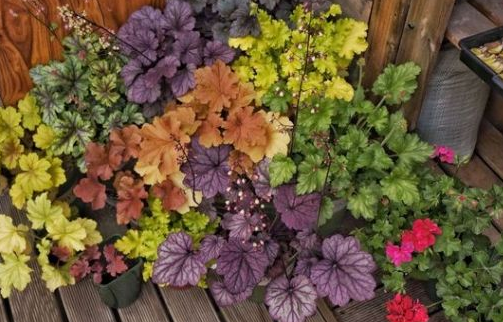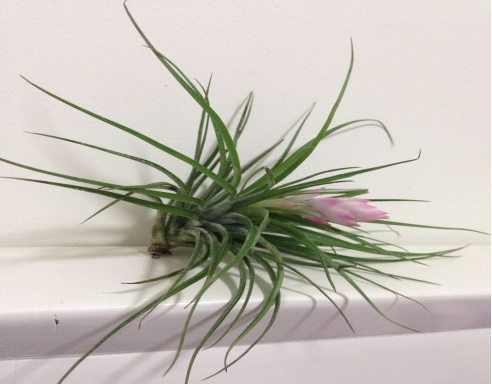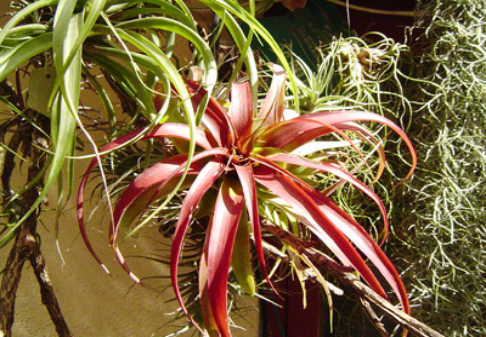How to raise alum root
1. Culture environment
Alum root likes to grow in a warm, moist and well-ventilated environment, and it has strong cold resistance and shade tolerance, but it likes sunlight very much. During its growth, give it enough sunlight so that it can grow well. Another point is that the soil he needs should be loose, breathable, fertile and slightly acidic.

2. Timely fertilization
Alum root should be fertilized in time in aquaculture, its demand for fertilizer is relatively large, it can apply long-term slow-release fertilizer at ordinary times, and some phosphate and potash fertilizer can be properly applied in its growing season, but it should be watered in time after each fertilization. only in this way can its roots absorb and utilize the nutrients in the fertilizer in time.
3. Light and temperature
Alum root likes to grow in a warm environment, and he also likes the sun very much. during the growing period, let it grow in plenty of sunlight, but pay attention to the fact that the summer temperature is too high and the sun is very strong, so you can't put the plant in the sun at this time. It will burn the plant, so it should be properly shaded. In winter, because the temperature is too low, it should be moved into the house for maintenance. And put it in a place where you can receive enough light.
The most suitable growth temperature of alum root is between 20 ℃ and 28 ℃. During these temperatures, it will grow very well, but it is also very hardy. Even at minus 10 degrees in winter, it still grows tenaciously and will not die.
The above is the introduction of how to raise alum root. Let's take a look at how alum root propagates.
How to raise alum root culture methods and matters needing attention
Alum root is a kind of ornamental plant with leaves as an ornamental. Its size is relatively small, and the colors of leaves are diversified. Generally, red, yellow, green and purple are the most common. Now many people will choose alum root for breeding, but most people are not very clear about its breeding method before breeding, so let's take a look at it!
How to raise alum root
1. The best breeding time: as long as you avoid the high temperature at noon in summer, you can reproduce all the year round.
2. The best growing soil: fertile, well-drained, neutral and acidic soil rich in humus.
3. Growth humidity requirements: do not like moisture, like semi-dry and wet environment.
4. The best growth temperature: the growth is good above 15 degrees below zero, but higher than 30 degrees, stop growing.
5, the best growth light: alum root cold-resistant, like Yang and Yin.
Alum root culture method
1. Light and temperature. Alum is cold-resistant, sunny and shady, so it is very suitable for maintenance in a cool semi-shady place. In summer, avoid direct sunlight, properly shade, and remember to keep ventilated. The alum root can be maintained in the sun in winter. The alum root is cold-resistant and can grow at a temperature above-15 ℃.
2. Alum root can be watered twice a week in summer, once a week in spring and autumn, and once a month in winter, even without watering. Watering is determined according to the tree condition of the plant. In addition, it can be watered in the afternoon in summer and less in the morning on a sunny day when it is cold in winter. Don't spray water on the core.
3. Fertilization. Culture alum root, we should also pay attention to proper fertilization, in fact, alum root in the soil with less fertilizer content, the growth will be better, but can also tolerate the soil with higher fertilizer content. You can add a little more nitrogen fertilizer.
4. Methods of reproduction. The propagation of alum root mainly adopts the methods of sowing propagation and separate plant propagation, and cutting propagation can also be used. Ramets of flowers, and so on the mother plant almost burst pot, can split. When dividing plants, pay attention to sterilization and disinfection, planting is not strict with the soil, if there are conditions, then slight acid, water retention and ventilation, get some peat soil mixed with perlite about four to one, regularly on the fertilizer, do not accumulate water.
Matters needing attention in alum root culture
1. Whether the alum root can be exposed in winter mainly depends on the temperature. Although alum root is a relatively cold-tolerant and shade-tolerant plant, the low temperature in winter can hurt it. In winter, it is necessary to decide whether to put it indoors or outdoors according to the climatic environment and the growth of alum roots.
2. When curing alum root, the soil must be loose and breathable, and some river sand can be mixed in the soil to increase air permeability and drainage. Watering should follow the principle of dryness and rewatering, especially in summer, do not cause root rot because of stagnant water.
3. Alum root likes light, and sufficient sunlight is beneficial to the growth of alum root. But the summer sun is too strong for the alum root, so the alum root needs to avoid direct sunlight in the summer, and can be maintained on a shaded balcony, or in a shady place, such as an air-conditioned room.
Diseases and insect pests of alum root and its control
1. No matter what kind of plants, diseases and insect pests are fatal blows. Once diseases and insect pests occur, they will affect the growth of plants and even make them die. Alum root is a newly introduced plant, diseases and insect pests are relatively rare, occasionally aphids, gray mold and root rot occur. Therefore, prevention is the main way to prevent diseases and insect pests.
2. In the process of maintenance, if you are worried about the threat of diseases and insect pests, you can often spray some pesticides or carbendazim for disinfection. The maintenance of the environment needs to be semi-shaded and kept cool to avoid direct sunlight, which can reduce the incidence of diseases and insect pests.
The culture method of alum root can start from its growth habits, pay special attention to its light and temperature when breeding, and shade well when it is hot in summer. The fertilizer and water technology of alum root is also very important, and an appropriate amount of fertilization in Jiaoshui River is an inevitable factor to ensure its growth.
The variety of alum root how to raise alum root
Alum Root how to raise alum Root
Alum root (Heuchera micrantha), also known as coral bell, Saxifragaceae alum root genus, perennial cold-resistant herbaceous flowers, shallow roots. Leaves basal, broad-shaped, 20-25cm long, dark purple, evergreen in warm regions, flowers small, bell-shaped, flower diameter 0.6-1.2cm, red, bilaterally symmetrical.
Like half-shade, resistant to full light; gardens are mostly used for under-forest flower border, ground cover, courtyard greening and so on. The florescence is from April to October. It is an ideal perennial flower border material. It is also a perennial perennial flower introduced from abroad in recent years.
Alum root, a beautiful colorful leaf plant, has many varieties, which can be divided into many colors just from the color of the leaves. What are the popular varieties of alum root?
A popular variety of alum root
Pilose alum root is a popular variety of alum root. The leaves of the pilose alum roots are covered with pilose and serrated edges.
The main varieties are golden citronella, supreme gold (the back of the leaf edge is light pink), Electra, orange caramel, and green strawberry whirlpool.
Safflower alum root
Safflower alum root, also known as coral bell, blossoms red, showing the shape of a bell.
The popular varieties on the market are the green series "waterfall", the back of the leaves is purple; the green series "Paris", the surface of the leaves is white; the green series "forest germ" is white-green between the veins; and the purple series, mixed-color variety "flower blanket".
Alum root
American alum root is a variety that entered the domestic market earlier, among which 'Purple Palace' is its representative and is widely cultivated in the early stage. this kind of alum root is hybridized by small flower alum root and hairy alum root.
Other varieties of caramel from alum root
Caramel is a kind of alum root, belongs to broad-leaf type, tidbits are conical.
Gardenia yellow
Gardenia yellow is also a kind of alum root. Compared with other alum roots, gardenia yellow blossoms later. Gardenia yellow from the leaf shape and color changes, people will be reminiscent of maple leaves.
Peach yellow
Peach yellow in the spring, the leaves show a delicate silver luster, mature leaves will be purple and slightly rosy.
Red sandstone red
Red sandstone red leaves will change from pink to bright copper yellow, and then to green with amber.
Aristocratic purple
The aristocratic purple will have pink-white flowers in summer, the leaves will remain stable purple, and the leaves will turn silver in winter.
Points for attention in cultivation
Alum root is a native plant in the United States, so it is widely used in the domestic landscape of the United States. Alum root is very easy to grow, no matter the light condition is full light or partial shade, whether the cultivated soil is slightly moist or slightly dry, whether the humidity is high or low, they can grow well.
The main results are as follows: 1. Cultivated in sunny place in winter, it is cold-tolerant and can grow at a temperature above-15 ℃.
2. grow in the semi-shade in summer, avoid strong light and avoid sunburn.
3. Use soil and fertilizer: plant in the soil with good drainage and add slow-release fertilizer. During the growth period, proper fertilization should be applied.
4. Watering: follow the principle of "dry and wet". The surface of the soil is dry and watered. Because you don't like being too wet, watering can be properly controlled in summer.
Plant the alum root in a sloping place. This is because they like substrates with good drainage. Although they can tolerate high fertilizer content or high pH value for a short time, alum roots grow more vigorously in soilless substrates with good drainage and low fertilizer content. A continuous supply of nitrogen to 50ppm ensures that they grow healthily. The pH value suitable for alum root growth is 5.8 to 6.2 and the EC value is 2 to 3.5. Each time the alum root should be watered thoroughly, and the matrix should be thoroughly dried before it is watered again. This can ensure the normal growth of plants, reduce the chance of plant infection, and prevent Fusarium, Pythium, Staphylosporum and so on.
- Prev

Maintenance of air pineapple
The varieties with gray leaves, white scales and thick and hard leaves prefer strong light; strong light and appropriate temperature are the key to make the petal color of air pineapple more attractive. Water air pineapple can be divided into thick leaves and thin leaves according to the thickness of leaves. Thick leaves like to dry.
- Next

Air pineapple after flowering
Ramets are usually carried out after the death of the mother plant of air pineapple. Cut off the tufted withered leaves on the mother plant, and then gently break off the seedlings with your hands, which is basically effortless. Don't lose the mother plant immediately. The withered air pineapple may produce more ramets.
Related
- Fuxing push coffee new agricultural production and marketing class: lack of small-scale processing plants
- Jujube rice field leisure farm deep ploughing Yilan for five years to create a space for organic food and play
- Nongyu Farm-A trial of organic papaya for brave women with advanced technology
- Four points for attention in the prevention and control of diseases and insect pests of edible fungi
- How to add nutrient solution to Edible Fungi
- Is there any good way to control edible fungus mites?
- Open Inoculation Technology of Edible Fungi
- Is there any clever way to use fertilizer for edible fungus in winter?
- What agents are used to kill the pathogens of edible fungi in the mushroom shed?
- Rapid drying of Edible Fungi

